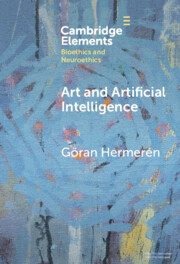References
ALLEA, All European Academies. European Code of Conduct for Research Integrity. Revised ed. Berlin: ALLEA, 2023.
Bell, Clive. Art. New York: Stokes, 1913.
Berger, John. The Shape of a Pocket. London: Penguin, 2001.
Berlyne, David. Aesthetics and Psychology. New York: Appleton-Century-Crofts of Meredith Corporation, 1971.
Boden, Margaret A. The Creative Mind: Myths and Mechanisms. 2nd ed. London: Routledge, 2004.
Boden, Margaret A. Creativity and Art: Three Roads to Surprise. Oxford: Oxford University Press, 2010a.
Boden, Margaret A. Creativity and Artificial Intelligence: A Contradiction in Terms? In Paul, Elliot Samuel and Kaufman, Scott Barry, eds., The Philosophy of Creativity: New Essays. Oxford: Oxford University Press, 2014: 224–244.
Broussard, Meredith. Artificial Unintelligence: How Computers Misunderstand the World. Cambridge, MA: MIT Press, 2018.
Carroll, Noël, ed. Theories of Art Today. Madison: University of Wisconsin Press, 2000.
Chalmers, David J. The Conscious Mind: In Search of a Fundamental Theory (Philosophy of Mind Series). New York: Oxford University Press, 1996.
Cohen, Ted. Aesthetics/Non-aesthetics and the Concept of Taste: A Critique of Sibley’s Position . Theoria 39 (1973): 113–152.
Crowther, Paul. Defining Art, Creating the Canon: Artistic Value in an Era of Doubt. Oxford: Oxford University Press, 2007.
Danto, Arthur. The Transfiguration of the Commonplace. Cambridge, MA: Harvard University Press, 1981.
Danto, Arthur. Beyond the Brillo Box. Berkeley: University of California Press, 1992.
Dennett, Daniel. The Zombic Hunch: Extinction of an Intuition? In O’Hear, A., ed., Philosophy at the New Millennium. Cambridge: Cambridge University Press, 2001: 27–43.
Dickie, George. Aesthetics: An Introduction. Indianapolis: Pegasus, Bobbs-Merrill, 1971.
Dickie, George. Art and the Aesthetic. Ithaca: Cornell University Press, 1974.
Dickie, George. The Art Circle. New York: Haven, 1984.
Dickie, George. Art and Value. Malden, MA: Blackwell, 2001.
Fry, Roger. Cézanne: A Study of His Development. New York: The Noonday Press, 1963.
Galanter, Philip. Towards Ethical Relationships with Machines That Make Art. In Burbano, Andrés and Ruth West, coord. , ‘AI, Arts & Design: Questioning Learning Machines’. Artnodes 26 (2020): 1–9. UOC. [Accessed 28 July 2023]. http://doi.org/10.7238/a.v0i26.3371. Gaut, Berys. ‘Art’ as a Cluster Concept. In Carroll, N., ed., Theories of Art Today. Madison: University of Wisconsin Press, 2000: 15–44.
Gaut, Berys. The Cluster Account of Art Defended. British Journal of Aesthetics 43 (2005): 273–288. Doi:10.1093/aesthj/ayi032.
Gaut, Berys. Art, Emotion and Ethics. Oxford: Clarendon Press, 2007.
Glannon, Walter. Ethics of Consciousness. Cambridge: Cambridge University Press, 2022.
Goldman, Alan. Aesthetic Value. Boulder, CO: Westview Press, 1995.
Gombrich, Ernst H. Art and Illusion. London: Phaidon, 1960.
Goodfellow, Ian et al. Generative Adversarial Nets. Paper presented at the Advances in Neural Information Processing Systems, Montreal, QC, Canada, 8–13 December 2014.
Gunkel, David J. Special Section: Rethinking Art and Aesthetics in the Age of Creative Machines. Editor’s Introduction. Philosophy & Technology 30 (2017): 263–265. https://doi.org/10.1007/s13347-017-0281-3. Hermerén, Göran. Representation and Meaning in the Visual Arts. Lund: Scandinavian University Books, 1969.
Hermerén, Göran. Aspects of Aesthetics. (Acta Regiae Societatis Humaniorum Litterarum Lundensis LXXVII). Lund: LiberFörlag/Gleerup, 1983.
Hermerén, Göran. The Nature of Aesthetic Qualities. Lund: Lund University Press, 1988.
Hermerén, Göran. Konst, konstvärlden och konstvärden. Lund: Vetenskapssocietetens Årsbok (2022): 63–83.
Honderich, Ted. How Free Are You? Oxford: Oxford University Press, 1993.
Hong, Joo-Wha and Curran, Nathaniel Ming. Artificial Intelligence, Artists and Art: Attitudes Toward Artwork Produced by Humans vs. Artificial Intelligence. ACM Transactions on Multimedia Computing, Communications, and Applications 15 (2019): 1–16. https://doi.org/10.1145/3326337. Johansson, Mats. Empatisk förståelse: Från inlevelse till osjälviskhet. Lund: Filosofiska institutionen, 2004.
Josephson, Ragnar. Konstverkets födelse. Lund: Studentlitteratur, 1991 (first published 1955).
Klee, Paul. Schöpferische Konfession. Berlin: Erich Reiss Verlag, 1920.
Levinson, Jerrold. Music, Art, and Metaphysics. Ithaca: Cornell University Press, 1990.
Levinson, Jerrold, ed. The Oxford Handbook of Aesthetics. Oxford: Oxford University Press, 2003.
Mackie, John L. The Cement of the Universe. Oxford: Clarendon Press, 1974.
Manovich, Lev. AI Aesthetics. Moscow: Strelka Press, 2019.
McCormack, Jon, Gifford, Toby and Hutchings, Patrick. Autonomy, Authenticity, Authorship and Intention in Computer Generated Art. arXiv:1903.02166v1 [cs.AI] 6 March 2019. https://doi.org/10.1007/978-3-030-16667-0_3. O’Hear, Anthony. Art and Technology: An Old Tension. In Fellows, R., ed., Philosophy and Technology. Cambridge: Cambridge University Press, 1995: 143–158.
Rose, Kevin. An A.I.-Generated Picture Won an Art Prize: Artists Aren’t Happy. The New York Times 2 September 2022.
Sahlin, Nils-Eric. Kreativitetens filosofi. Nora: Nya Doxa, 2006.
Samo, Andrew and Highhouse, Scott. Artificial Intelligence and Art: Identifying the Aesthetic Judgment Factors that Distinguish Human- and Machine-Generated Artwork. Psychology of Aesthetics, Creativity, and the Arts (2023): 1–15. https://dx.doi.org/10.1037/aca0000570. Schellekens, Elisabeth. The Aesthetic Value of Ideas. In Goldie, Peter and Schellekens, Elisabeth, eds., Philosophy and Conceptual Art. Oxford: Oxford University Press, 2007: 71–91.
Schneider, Tim and Rea, Naomi. Has Artificial Intelligence Given Us the Next Great Art Movement? Experts Say Slow Down, the ‘Field Is in Its Infancy’. Artnet 25 September 2018.
Sibley, Frank. Aesthetic Concepts. Philosophical Review 68 (1959): 421–450; reprinted, with revisions, in Joseph Margolis, ed., Philosophy Looks at the Arts. Philadelphia: Temple University Press, 1987; and in his Approach to Aesthetics, ed. John Benson, Betty Redfern and Jeremy Roxbee Cox. Oxford: Clarendon Press, 2001.
Spalding, Julian. Sell Your Damien Hirsts while You Can. Scotts Valley: CreateSpace Independent Publishing Platform, 2012.
Stecker, Robert. Artistic Value Defended. Journal of Aesthetics and Art Criticism 70, 4 (2012): 355–362.
Tännsjö, Torbjörn. Människan är inte unik. Dagens Nyheter 2 June 2023.
Tolstoy, Leo. What Is Art? London: Penguin, 1995 (first published 1897).
Vaida, Juliana Corina. The Quest for Objectivity: Secondary Qualities and Aesthetic Qualities. Journal of Aesthetics and Art Criticism 56 (1998): 283–297. https://www.jstor.org/stable/43496530. Van der Steen, Jenny T, Wouden, van der, Johannes C et al. Music-Based Therapeutic Interventions for People with Dementia. Cochrane Database of Systematic Reviews 7 (2018): 1–99. Art No: CD003477.
Wind, Edgar. Bellini’s Feast of the Gods. Cambridge, MA: Harvard College Library, 1948.
Wollheim, Richard. Art and Its Objects. 2nd edition. New York: Cambridge University Press, 1980.
Young, Edward. Conjectures on Original Composition. Reprinted: Franklin Classics 2018 (first published in 1759).
Zylinska, Joanna. AI Art: Machine Visions and Warped Dreams. London: Open Humanities Press, 2020.



